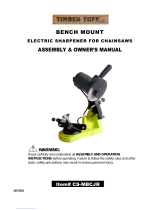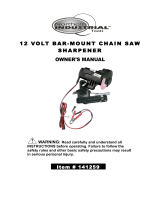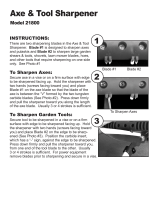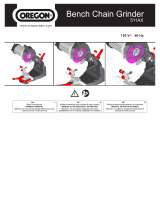Page is loading ...

INSTRUCTION MANUAL
Utility Sharpener
(Model GR050)
PART NO. 906996 - 08-06-02
Copyright © 2002 Delta Machinery
ESPAÑOL: PÁGINA 11
To learn more about DELTA MACHINERY
visit our website at: www.deltamachinery.com.
For Parts, Service, Warranty or other Assistance,
please call
1-800-223-7278 (In Canada call 1-800-463-3582).

2
GENERAL SAFETY RULES
Woodworking can be dangerous if safe and proper operating procedures are not followed. As with all machinery, there
are certain hazards involved with the operation of the product. Using the machine with respect and caution will
considerably lessen the possibility of personal injury. However, if normal safety precautions are overlooked or ignored,
personal injury to the operator may result. Safety equipment such as guards, push sticks, hold-downs, featherboards,
goggles, dust masks and hearing protection can reduce your potential for injury. But even the best guard won’t make
up for poor judgment, carelessness or inattention. Always use common sense
and exercise caution in the workshop.
If a procedure feels dangerous, don’t try it. Figure out an alternative procedure that feels safer. REMEMBER: Your
personal safety is your responsibility.
This machine was designed for certain applications only. Delta Machinery strongly recommends that this machine not
be modified and/or used for any application other than that for which it was designed. If you have any questions relative
to a particular application, DO NOT use the machine until you have first contacted Delta to determine if it can or should
be performed on the product.
Technical Service Manager
Delta Machinery
4825 Highway 45 North
Jackson, TN 38305
(IN CANADA: 505 SOUTHGATE DRIVE, GUELPH, ONTARIO N1H 6M7)
WARNING: FAILURE TO FOLLOW THESE RULES MAY RESULT IN SERIOUS PERSONAL INJURY
1. FOR YOUR OWN SAFETY, READ INSTRUCTION
MANUAL BEFORE OPERATING THE TOOL. Learn the
tool’s application and limitations as well as the specific
hazards peculiar to it.
2. KEEP GUARDS IN PLACE and in working order.
3. ALWAYS WEAR EYE PROTECTION.
Wear safety
glasses. Everyday eyeglasses only have impact resistant
lenses; they are not safety glasses. Also use face or dust
mask if cutting operation is dusty. These safety glasses
must conform to ANSI Z87.1 requirements. NOTE:
Approved glasses have Z87 printed or stamped on them.
4. REMOVE ADJUSTING KEYS AND WRENCHES. Form
habit of checking to see that keys and adjusting wrenches
are removed from tool before turning it “on”.
5. KEEP WORK AREA CLEAN. Cluttered areas and
benches invite accidents.
6. DON’T USE IN DANGEROUS ENVIRONMENT. Don’t
use power tools in damp or wet locations, or expose them
to rain. Keep work area well-lighted.
7. KEEP CHILDREN AND VISITORS AWAY. All children
and visitors should be kept a safe distance from work area.
8. MAKE WORKSHOP CHILDPROOF – with padlocks,
master switches, or by removing starter keys.
9. DON’T FORCE TOOL. It will do the job better and be
safer at the rate for which it was designed.
10. USE RIGHT TOOL. Don’t force tool or attachment to
do a job for which it was not designed.
11. WEAR PROPER APPAREL. No loose clothing, gloves,
neckties, rings, bracelets, or other jewelry to get caught in
moving parts. Nonslip footwear is recommended. Wear
protective hair covering to contain long hair.
12. SECURE WORK. Use clamps or a vise to hold work
when practical. It’s safer than using your hand and frees
both hands to operate tool.
13. DON’T OVERREACH. Keep proper footing and
balance at all times.
14. MAINTAIN TOOLS IN TOP CONDITION. Keep tools
sharp and clean for best and safest performance. Follow
instructions for lubricating and changing accessories.
15. DISCONNECT TOOLS before servicing and when
changing accessories such as blades, bits, cutters, etc.
16. USE RECOMMENDED ACCESSORIES. The use of
accessories and attachments not recommended by Delta
may cause hazards or risk of injury to persons.
17. REDUCE THE RISK OF UNINTENTIONAL STARTING.
Make sure switch is in “OFF” position before plugging in
power cord.
In the event of a power failure, move switch
to the “OFF” position.
18. NEVER STAND ON TOOL. Serious injury could occur if
the tool is tipped or if the cutting tool is accidentally
contacted.
19. CHECK DAMAGED PARTS. Before further use of the
tool, a guard or other part that is damaged should be
carefully checked to ensure that it will operate properly and
perform its intended function – check for alignment of
moving parts, binding of moving parts, breakage of parts,
mounting, and any other conditions that may affect its
operation. A guard or other part that is damaged should be
properly repaired or replaced.
20. DIRECTION OF FEED. Feed work into a blade or
cutter against the direction of rotation of the blade or cutter
only.
21. NEVER LEAVE TOOL RUNNING UNATTENDED.
TURN POWER OFF. Don’t leave tool until it comes to a
complete stop.
22.
STAY ALERT, WATCH WHAT YOU ARE DOING, AND
USE COMMON SENSE WHEN OPERATING A POWER
TOOL. DO NOT USE TOOL WHILE TIRED OR UNDER
THE INFLUENCE OF DRUGS, ALCOHOL, OR
MEDICATION. A moment of inattention while operating
power tools may result in serious personal injury.
23. MAKE SURE TOOL IS DISCONNECTED FROM
POWER SUPPLY while motor is being mounted,
connected or reconnected.
24. THE DUST GENERATED by certain woods and wood
products can be injurious to your health. Always operate
machinery in well ventilated areas and provide for proper
dust removal. Use wood dust collection systems whenever
possible.
25.
WARNING: SOME DUST CREATED BY
POWER SANDING, SAWING, GRINDING, DRILLING,
AND OTHER CONSTRUCTION ACTIVITIES contains
chemicals known to cause cancer, birth defects or other
reproductive harm. Some examples of these chemicals
are:
· lead from lead-based paints,
· crystalline silica from bricks and cement and other
masonry products, and
· arsenic and chromium from chemically-treated lumber.
Your risk from these exposures varies, depending on how
often you do this type of work. To reduce your exposure
to these chemicals: work in a well ventilated area, and
work with approved safety equipment, such as those
dust masks that are specially designed to filter out
microscopic particles.
SAVE THESE INSTRUCTIONS.
Refer to them often and use them to instruct others.

ADDITIONAL SAFETY RULES FOR
UTILITY SHARPENERS
3
WARNING: FAILURE TO FOLLOW THESE RULES MAY RESULT IN SERIOUS PERSONAL INJURY.
SAVE THESE INSTRUCTIONS.
Refer to them often
and use them to instruct others.
1. DO NOT OPERATE THIS MACHINE until it is
assembled and installed according to the
instructions.
2. OBTAIN ADVICE FROM YOUR SUPERVISOR,
instructor, or another qualified person if you are
not familiar with the operation of this machine.
3. FOLLOW ALL WIRING CODES and recommended
electrical connections.
4.
TO AVOID THE POSSIBILITY OF THE APPLIANCE
PLUG OR RECEPTACLE GETTING WET, POSITION
MACHINE TO ONE SIDE OF A WALL MOUNTED
RECEPTACLE TO PREVENT WATER FROM
DRIPPING ONTO THE RECEPTACLE OR PLUG. The
user should arrange a “drip loop” in the cord
connecting the machine to a receptacle. The “drip
loop” is that part of the cord below the level of the
receptacle, or the connector if an extension cord is
used, to prevent water traveling along the cord and
coming in contact with the receptacle.
5.
IF THE PLUG OR RECEPTACLE DOES GET WET,
DON’T UNPLUG THE CORD. Disconnect the fuse
or circuit breaker that supplies power to the machine.
Then unplug and examine for presence of water in
the receptacle.
6. GROUND FAULT CIRCUIT INTERRUPTER (GFCI)
PROTECTION SHOULD BE PROVIDED ON THE
CIRCUIT(S) OR OUTLET(S) TO BE USED WITH
THE MACHINE.
7. INSPECT GRINDING WHEELS for chips or cracks
before starting the machine. DO NOT USE THE
UTILITY SHARPENER IF THE WHEEL IS
DAMAGED IN ANY WAY.
8. ADJUST TOOL RESTS close to the grinding wheel
(1/8" (3.8mm) separation or less). Tighten the tool
rest securely to prevent shifting positions.
9. STAND TO ONE SIDE before turning the machine
“ON”.
10. NEVER GRIND ON A COLD GRINDING WHEEL.
Run the grinder at idle speed for one full minute
before applying the workpiece.
11. NEVER START THE MACHINE with the workpiece
against the grinding wheel.
12. NEVER GRIND NEAR FLAMMABLE GAS OR
LIQUIDS. Sparks can create a fire or an explosion.
13. AVOID AWKWARD OPERATIONS AND HAND
POSITIONS where a sudden slip could cause a
hand to move into the grinding wheel.
14. KEEP ARMS, HANDS, AND FINGERS away from
the grinding wheel.
15. HOLD WORK FIRMLY against the tool rests.
16. DRESS THE GRINDING WHEEL on the face only.
Dressing the side of the grinding wheel could cause
it to become too thin for safe use.
17. GRIND A WORKPIECE using the face of the
grinding wheel only.
18. DO NOT TOUCH the ground portion of a workpiece
until it has cooled sufficiently. Grinding creates heat.
19. TURN THE MACHINE “OFF” AND DISCONNECT
THE MACHINE from the power source before
installing or removing accessories, before adjusting
or changing set-ups, or when making repairs.
20. TURN THE MACHINE “OFF”, disconnect the
machine from the power source, and clean the
table/work area before leaving the machine. If your
machine has a switch lock-out feature, LOCK THE
SWITCH IN THE “OFF” POSITION to prevent
unauthorized use.
21. ADDITIONAL INFORMATION regarding the safe
and proper operation of this tool is available from
the Power Tool Institute, 1300 Summer Avenue,
Cleveland, OH 44115-2851. Information is also
available from the National Safety Council, 1121
Spring Lake Drive, Itasca, IL 60143-3201. Please
refer to the American National Standards Institute
ANSI 01.1 Safety Requirements for Woodworking
Machines and the U.S. Department of Labor OSHA
1910.213 Regulations.

4
POWER CONNECTIONS
GROUND FAULT CIRCUIT INTERRUPTER (GFCI) PROTECTION SHOULD BE PROVIDED ON THE CIRCUIT(S) OR
OUTLET(S) TO BE USED FOR THE UTILITY SHARPENER. A separate electrical circuit should be used for your
machines. This circuit should not be less than #12 wire and should be protected with a 20 Amp time lag fuse. If an
extension cord is used, use only 3-wire extension cords which have 3-prong grounding type plugs and matching
receptacle which will accept the machine’s plug. Before connecting the machine to the power line, make sure the
switch is in the “OFF” position and be sure that the electric current is of the same characteristics as indicated on the
machine. All line connections should make good contact. Running on low voltage will damage the motor.
WARNING: DO NOT EXPOSE THE MACHINE TO RAIN OR OPERATE THE MACHINE IN DAMP LOCATIONS.
MOTOR SPECIFICATIONS
Your machine is wired for 120 volt, 60 HZ alternating current. Before connecting the machine to the power source,
make sure the switch is in the “OFF” position.
GROUNDING INSTRUCTIONS
WARNING: THIS MACHINE MUST BE GROUNDED WHILE IN USE TO PROTECT THE OPERATOR FROM
ELECTRIC SHOCK.
Fig. A Fig. B
GROUNDED OUTLET BOX
CURRENT
CARRYING
PRONGS
GROUNDING BLADE
IS LONGEST OF THE 3 BLADES
GROUNDED OUTLET BOX
GROUNDING
MEANS
ADAPTER
2. Grounded, cord-connected machines intended for use
on a supply circuit having a nominal rating less than 150
volts:
If the machine is intended for use on a circuit that has an
outlet that looks like the one illustrated in Fig. A, the
machine will have a grounding plug that looks like the plug
illustrated in Fig. A. A temporary adapter, which looks like
the adapter illustrated in Fig. B, may be used to connect
this plug to a matching 2-conductor receptacle as shown
in Fig. B if a properly grounded outlet is not available. The
temporary adapter should be used only until a properly
grounded outlet can be installed by a qualified electrician.
The green-colored rigid ear, lug, and the like, extending
from the adapter must be connected to a permanent
ground such as a properly grounded outlet box. Whenever
the adapter is used, it must be held in place with a metal
screw.
NOTE: In Canada, the use of a temporary adapter is not
permitted by the Canadian Electric Code.
WARNING: IN ALL CASES, MAKE CERTAIN THE
RECEPTACLE IN QUESTION IS PROPERLY
GROUNDED. IF YOU ARE NOT SURE HAVE A
QUALIFIED ELECTRICIAN CHECK THE RECEPTACLE.
1. All grounded, cord-connected machines:
In the event of a malfunction or breakdown, grounding
provides a path of least resistance for electric current to
reduce the risk of electric shock. This machine is
equipped with an electric cord having an equipment-
grounding conductor and a grounding plug. The plug must
be plugged into a matching outlet that is properly installed
and grounded in accordance with all local codes and
ordinances.
Do not modify the plug provided - if it will not fit the outlet,
have the proper outlet installed by a qualified electrician.
Improper connection of the equipment-grounding
conductor can result in risk of electric shock. The
conductor with insulation having an outer surface that is
green with or without yellow stripes is the equipment-
grounding conductor. If repair or replacement of the
electric cord or plug is necessary, do not connect the
equipment-grounding conductor to a live terminal.
Check with a qualified electrician or service personnel if
the grounding instructions are not completely
understood, or if in doubt as to whether the machine is
properly grounded.
Use only 3-wire extension cords that have 3-prong
grounding type plugs and matching 3-conductor
receptacles that accept the machine’s plug, as shown in
Fig. A.
Repair or replace damaged or worn cord immediately.

Use proper extension cords. Make sure your extension cord is in good condition and is a 3-wire extension cord which
has a 3-prong grounding type plug and matching receptacle which will accept the machine’s plug. When using an
extension cord, be sure to use one heavy enough to carry the current of the machine. An undersized cord will cause
a drop in line voltage, resulting in loss of power and overheating. Fig. D, shows the correct gauge to use depending
on the cord length. If in doubt, use the next heavier gauge. The smaller the gauge number, the heavier the cord.
EXTENSION CORDS
OPERATING INSTRUCTIONS
FOREWORD
Delta ShopMaster Model GR050 Utility Sharpener is a valuable addition to any shop. The Utility Sharpener can be used
to sharpen most flat cutting tools.
UNPACKING AND CLEANING
Carefully unpack the machine and all loose items from the shipping container(s). Remove the protective coating from
all unpainted surfaces. This coating may be removed with a soft cloth moistened with kerosene (do not use acetone,
gasoline or lacquer thinner for this purpose). After cleaning, cover the unpainted surfaces with a good quality household
floor paste wax.
NOTICE: THE MANUAL COVER PHOTO ILLUSTRATES THE CURRENT
PRODUCTION MODEL. ALL OTHER ILLUSTRATIONS ARE REPRESENTATIVE
ONLY AND MAY NOT DEPICT THE ACTUAL COLOR, LABELING OR
ACCESSORIES AND MAY BE INTENDED TO ILLUSTRATE TECHNIQUE ONLY.
5
Fig. D
MINIMUM GAUGE EXTENSION CORD
RECOMMENDED SIZES FOR USE WITH STATIONARY ELECTRIC MACHINES
Ampere Total Length Gauge of
Rating Volts of Cord in Feet Extension Cord
0-6 120
up to
25 18 AWG
0-6 120 25-50 16 AWG
0-6 120 50-100 16 AWG
0-6 120 100-150 14 AWG
6-10 120
up to
25 18 AWG
6-10 120 25-50 16 AWG
6-10 120 50-100 14 AWG
6-10 120 100-150 12 AWG
10-12 120
up to
25 16 AWG
10-12 120 25-50 16 AWG
10-12 120 50-100 14 AWG
10-12 120 100-150 12 AWG
12-16 120
up to
25 14 AWG
12-16 120 25-50 12 AWG
12-16 120
GREATER THAN 50 FEET NOT RECOMMENDED

6
UTILITY SHARPENER COMPONENTS
Fig. 2
1
2
3
4
5
6
7
1. Forward / Off / Reverse Control Switch
2. Front Tool Rest
3. Front Tool Rest Adjusting Screws
4. Hex Wrench
5. Rear Tool Rest Adjusting Screws
6. Rear Tool Rest
7. Grinding Wheel

7
FILLING UTILITY SHARPENER WITH WATER
1. WARNING: DISCONNECT MACHINE FROM
POWER SOURCE.
2. Place the utility sharpener on a flat surface.
3. Loosen the the front tool rest adjusting screw (A) Fig. 3,
and move the front tool rest away from the grinding wheel.
4. Pour approximately 3 ounces of water into the front of
water trough (B) Fig. 3. CAUTION: NEVER POUR WATER
INTO THE UTILITY SHARPENER WHILE IT IS RUNNING.
5. WARNING: Before connecting the machine to
the power circuit, make sure power switch is OFF and the
power circuit voltage is the same as that shown on the
specification plate. Connect machine to power circuit. To
avoid the possibility of the appliance plug or receptacle
getting wet, position the machine to one side of a wall
mounted receptacle to prevent water from dripping onto
the receptacle or plug. The user should arrange a “drip
loop” Fig. 4, in the cord connecting the machine to a
receptacle. The “drip loop” is that part of the cord below
the level of the receptacle, or the connector if an
extension cord is used, to prevent water traveling along
the cord and coming in contact with the receptacle.
6. Turn the power switch “ON”, and let the machine run
for one minute. The grinding wheel will absorb some of
the water.
7. Turn the power switch “OFF” and disconnect
machine from power source.
8. Fill the water trough until the water is almost reaching
the level of the drainage opening (A) Fig. 5, in the rear of
the machine. The water trough should be checked and
refilled periodically during use.
9. Reposition front tool rest, and tighten tool rest
adjusting screw. WARNING: Always maintain a
distance of 1/8" or less between the grinding wheel and
the inside edge of the tool rest.
10. Connect machine to power source. WARNING:
The user should arrange a “drip loop” Fig. 4, in the cord
connecting the machine to a receptacle. The “drip loop”
is that part of the cord below the level of the receptacle,
or the connector if an extension cord is used, to prevent
water traveling along the cord and coming in contact with
the receptacle.
11. When finished grinding with the utility sharpener,
disconnect machine from power source and tilt the
machine to the rear to drain the water through the
opening (A) Fig. 5.
Fig. 3
Fig. 4
Fig. 5
A
A
B

8
OPERATING CONTROLS AND ADJUSTMENTS
STARTING AND STOPPING
UTILITY SHARPENER
The “Forward / Off / Reverse” switch (A) Fig. 6, is located
toward the front of the machine. To turn the machine
“ON”, move the switch to the “Forward” or “Reverse”
position. The wheel will turn in the direction indicated by
the arrows. In the “Forward” position, the wheel will
rotate toward the front of the machine. In the “Reverse”
position, the wheel will rotate toward the rear of the
machine. To turn the machine “OFF”, move the switch to
the center “OFF” position.
Fig. 6
TOOL RESTS
Each tool rest assembly (D) Fig. 7, is adjustable so it can
be positioned as close to the grinding wheel as possible,
giving maximum support to the piece that is being
ground. Always maintain a distance of 1/8" or less
between the grinding wheel and the inside edge of the
tool rest. WARNING: As the wheels wear down, the
tool rest should be adjusted accordingly. When the tool
rests are positioned correctly, tighten screws (C) and (F)
with hex wrench (G).
Fig. 7
D
D
C
F
G
A
MAINTENANCE
1. DISCONNECT MACHINE FROM POWER SOURCE.
2. Clean the machine with a clean dry rag. WARNING: DO NOT USE FLAMMABLE MATERIALS TO CLEAN THE
UTILITY SHARPENER.
3. Inspect the wheel for any chips or cracks.
WARNING: DO NOT USE THE UTILITY SHARPENER IF THE WHEEL IS DAMAGED IN ANY WAY.
SHARPENING HINTS
1. Before sharpening an item, make sure the item is clean, and free of any loose particles.
2. When sharpening an item, use light pressure, and pass the item across the wheel until a fine edge is produced.
Heavy pressure will cause the edge to be ragged.
3. Do not sharpen tools, blades, bits, etc, that are bent or cracked. These items should be discarded.
4. The Utility Sharpener should not be used to remove large amounts of material. The Utility Sharpener uses a much
finer grit wheel, and rotates at a slower pace then a bench grinder.

9
NOTES

10
Two Year Limited Warranty
Delta will repair or replace, at its expense and at its option, any Delta machine, machine part, or machine accessory which
in normal use has proven to be defective in workmanship or material, provided that the customer returns the product
prepaid to a Delta factory service center or authorized service station with proof of purchase of the product within two
years and provides Delta with reasonable opportunity to verify the alleged defect by inspection. Delta may require that
electric motors be returned prepaid to a motor manufacturer’s authorized station for inspection and repair or replacement.
Delta will not be responsible for any asserted defect which has resulted from normal wear, misuse, abuse or repair or
alteration made or specifically authorized by anyone other than an authorized Delta service facility or representative. Under
no circumstances will Delta be liable for incidental or consequential damages resulting from defective products. This
warranty is Delta’s sole warranty and sets forth the customer’s exclusive remedy, with respect to defective products; all
other warranties, express or implied, whether of merchantability, fitness for purpose, or otherwise, are expressly
disclaimed by Delta.
Printed in U.S.A.
PARTS, SERVICE OR WARRANTY ASSISTANCE
All Delta Machines and accessories are manufactured to high quality standards and are serviced by a network
of Porter-Cable • Delta Factory Service Centers and Delta Authorized Service Stations. To obtain additional
information regarding your Delta quality product or to obtain parts, service, warranty assistance, or the location
of the nearest service outlet, please call 1-800-223-7278 (In Canada call 1-800-463-3582).
ACCESSORIES
A complete line of accessories is available from your Delta Supplier, Porter-Cable • Delta Factory Service Centers,
and Delta Authorized Service Stations. Please visit our Web Site www.deltamachinery.com for a catalog or
for the name of your nearest supplier.
WARNING: Since accessories other than those offered by Delta have not been tested
with this product, use of such accessories could be hazardous. For
safest operation, only
Delta recommended accessories should be used with this product.
/



